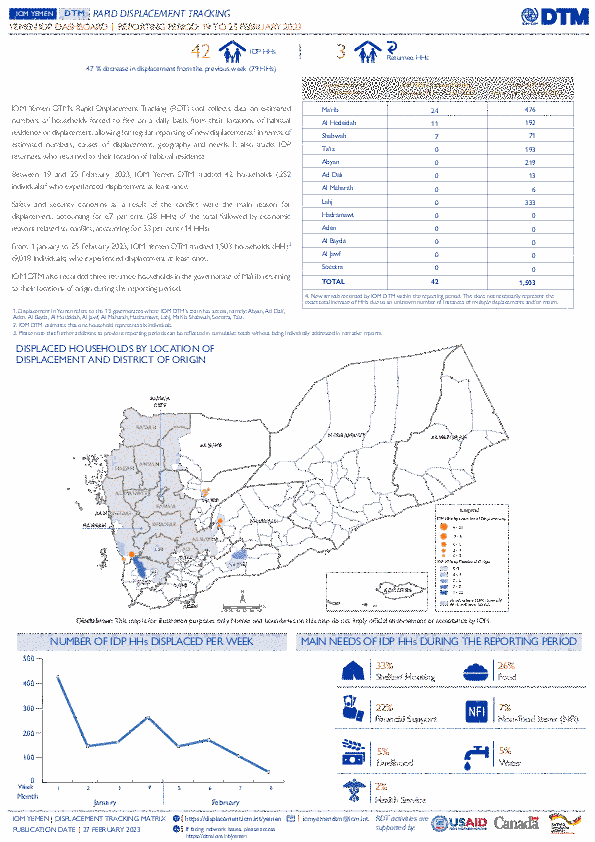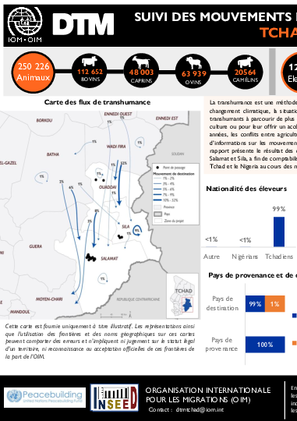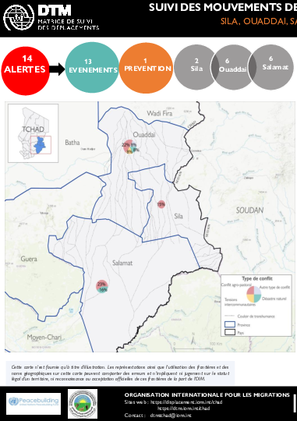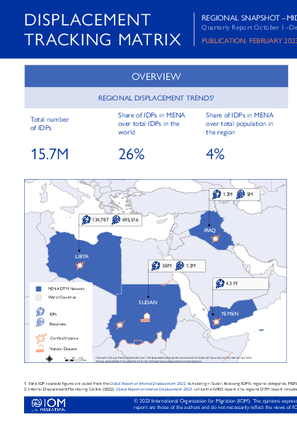-
Countries
-
Data and Analysis
-
Special Focus
-
Crisis Responses

Contact
DTMMozambique@iom.int
Language
English
Location
Mozambique
Period Covered
Feb 24 2023
Feb 27 2023
Activity
- Event Tracking
Mozambique’s National Institute for Disaster Management (INGD) estimates 1.75 million people to be affected by recent floods and subsequent landfall of the tropical storm Freddy across central and southern Mozambique. Making landfall on 24 February 2023, Tropical Storm Freddy has impacted the provinces of Gaza, Inhambane, Manica, Sofala and Zambezia. As of 27 February 2023, available reports indicate 3,075 individuals (851 families) have taken shelter in 7 accommodation centres (ACs) across Sofala, 135 individuals (36 families) in 2 ACs across Inhambane and 5,581 individuals (1,269 families) in 13 ACs in Gaza. The majority of these centres are schools and churches. Reported priority needs include WASH, protection, health, food and emergency shelters. As rain and flood conditions develop, ongoing joint assessments with INGD and humanitarian partners monitor the needs and conditions of affected populations in the region. For further information see Mozambique: Severe Tropical Storm Freddy and Floods - Flash Update No.5 (as of 26 February 2023).

Contact
DTMRCA@iom.int
Language
English
Location
Central African Republic
Period Covered
Dec 08 2022
Jan 08 2023
Activity
- Survey
- Return Intention
L’enquête a été réalisée dans 72 sites de déplacement situés a été menée par la matrice de suivi des déplacements dans les préfectures comptant des sites de déplacement en (Displacement Tracking Matrix, DTM) entre le 08 décembre RCA (en dehors de Bangui et Ombella-Mpoko) : Bamingui- 2022 et le 08 janvier 2023 sur les sites hébergeant des Bangoran, Haute-Kotto, Haut-Mbomou, Mbomou, Nana- populations déplacées internes (PDI).
Contact
DTM Burundi, DTMBurundi@iom.int
Location
Burundi
Activity
- Mobility Tracking
- Event Tracking
Period Covered
Feb 19 2023 -Feb 25 2023
Activated on an ad hoc basis, the DTM Emergency Tracking provides early field reports at the beginning of a complex crisis, allowing IOM to gather, consolidate and disseminate baseline information on displacement and return figures at the onset of a newly emerging crisis. The DTM Emergency Tracking relies heavily on information provided by RARTs or partners within the humanitarian community about an unfolding situation. The Emergency Tracking gathers data through IOM Burundi’s extended network of key informants, who provide basic information on the new displacement, be it of IDPs or returnees, or both, including numbers, location and shelter types. While IOM DTM strives to provide best estimates, the Emergency Tracking aims to be a quick monitoring tool with real-time data turnover ranging from 24 to 72 hours following its activation.
Population Groups
Survey Methodology
Unit of Analysis Or Observation
Type of Survey or Assessment
Keywords
Geographical Scope
Administrative boundaries with available data
The current dataset covers the following administrative boundaries

Contact
DTM Libya, DTMLibya@iom.int
Language
English
Location
Libya
Snapshot Date
Feb 27 2023
Activity
- Other
This background paper on Nigerien Migrant Workers in Libya aims to provide an overview of the situation and opportunities for this population. It was produced with the aim of guiding the operationalisation of a Memorandum of Understanding (MoU) on labour migration signed by both states in 2021. The document was initiated by Labour Mobility and Social Inclusion (LMI) unit, using DTM data sources, including IOM’s Flow Monitoring Survey (FMS) as well as qualitative interviews with Nigerien migrant workers collected in June 2022. The report provides significant insights into Nigerien migrant workers conditions, including their mode of entry in Libya; employment status; access to documentation; ability to send remittances and mobility intentions.
The paper emphasizes that Nigerien migrants play a vital role in Libyan economy, providing a much-needed skilled workforce. As such, the operationalisation and creation of regular pathways between Niger and Libya is paramount to ensure the protection of Nigerien Migrant workers in Libya.
The Displacement Tracking Matrix (DTM) provides primary data and information on internal displacement and population movements – incountry and at regional and global levels. DTM’s work worldwide informs humanitarian, recovery, transition and development interventions by providing timely data and analysis to relevant actors including governments, United Nations partner agencies, donors and other stakeholders. DTM operates in contexts where conflict, natural disasters and complex emergency settings can cause short-term or protracted displacement, as well as in mixed migration contexts. In the Middle East and North Africa (MENA) region, there were 15.7 million internally displaced persons (IDPs) in 2021. This figure constitutes 26 per cent of the global population of IDPs, making MENA the region with the second highest concentration of IDPs worldwide (following the sub-Saharan Africa region). Most displacement in the MENA region (81%) has been triggered by armed conflict, in particular in Iraq, Libya, Syria and Yemen.

Contact
DTM Yemen, iomyemendtm@iom.int
Language
English
Location
Yemen
Period Covered
Feb 19 2023
Feb 25 2023
Activity
- Mobility Tracking
IOM Yemen DTM’s Rapid Displacement Tracking (RDT) tool collects data on estimated numbers of households forced to flee on a daily basis from their locations of origin or displacement, allowing for regular reporting of new displacements in terms of estimated numbers, geography, and needs. It also tracks returnees who returned to their location of origin.
From 1 January to 25 February 2023, IOM Yemen DTM tracked 1,503 households (HH) (9,018 Individuals) who experienced displacement at least once.
Between 19 and 25 February 2023, IOM Yemen DTM tracked 42 households (252 individuals) displaced at least once. The majority of people moved into/within the following governorates and districts:
- Ma’rib (24 HHs) – Ma’rib City (23 HHs), Ma’rib (1 HH) districts. Most displacements in the governorate originated from Ibb and Ta’iz.
- Al Hodeidah (11 HHs) – Hays (7 HHs), Al Khukhah (4 HHs) districts. Most displacements in the governorate originated from Ta’iz and Al Hodeidah.
- Shabwah (7 HHs) – Bayhan (7 HHs) district. Most displacements in the governorate originated from Abyan and Al Bayda.
The majority of people moved from the following governorates and districts:
- Ta’iz (11 HHs) – Maqbanah (7 HHs), Mawiyah (2 HHs), Al Mawasit (2 HHs) districts.
- Al Hodeidah (6 HHs) – At Tuhayta (4 HHs), Al Jarrahi (2 HHs) districts.
- Abyan (6 HHs) – Mudiyah (5 HHs), Al Wadi (1 HH) districts.

Contact
DTM Chad, DTMTchad@iom.int
Language
French
Location
Chad
Period Covered
Nov 01 2022
Dec 31 2022
Activity
- Survey
- Flow Monitoring
La transhumance est une méthode d’élevage par laquelle les éleveurs accompagnent leurs troupeaux à la recherche de pâturages et de points d’eau. Le changement climatique, la situation économique morose et la diminution des pâturages et point d’eau ont accentué ce phénomène, poussant les transhumants à parcourir de plus longues distances. Des couloirs de passage sont aménagés pour faire place au passage des animaux dans les zones de culture ou pour leur offrir un accès à l’eau. Le déplacement des troupeaux le long de ces couloirs peut affecter les récoltes des paysans. Ces dernières années, les conflits entre agriculteurs et éleveurs le long des couloirs de transhumance sont devenus de plus en plus récurrents. Pour fournir plus d’informations sur les mouvements de transhumance, l’OIM a développé l’outil de Suivi de transhumances (Transhumance Tracking Tool, TTT). Ce rapport présente le résultat des collectes effectuées par les énumérateurs au niveau de points stratégiques dans les provinces de : Batha, Ouaddaï, Salamat et Sila, a fin de comptabiliser le nombre d'animaux passant la frontière dans le but de fournir une estimation des flux de transhumances entre le Tchad et le Nigeria au cours des mois de novembre et décembre 2022.

Contact
DTM Chad, DTMTchad@iom.int
Language
French
Location
Chad
Period Covered
Oct 01 2022
Dec 31 2022
Activity
- Survey
- Flow Monitoring
Le Tchad est l’un des plus grands pays d’élevage d’Afrique et compte près de 94 millions de têtes de bétails (Ministère de l’Elevage et des Ressources Animales, 2016). Cependant, le mode d’élevage est de type traditionnel extensif, caractérisé par la mobilité des animaux en quête de point d’eau et de pâturage (Madina A. Affadine, 2018). Ces ressources se réduisent en quantité et en qualité au fil du temps avec les effets des aléas climatiques et des actions anthropiques (PNUD et al, 2012). Ainsi, la forte pression sur les ressources tend à dégrader les rapports entre éleveurs et agriculteurs. Les conflits d’usage sont devenus récurrents, d’une part, entre agriculteurs et éleveurs, d’autre part, entre les éleveurs eux-mêmes. En effet, pour mieux comprendre la dynamique des mouvements de transhumance et son impact, l’OIM, à travers sa Matrice de suivi des déplacements (Displacement Tracking Matrix – DTM), a mis en place l’outil de suivi des mouvements de transhumance (Transhumance Tracking Tool – TTT) avec le réseau de la confédération des organisations professionnelles des pasteurs des acteurs de la filières bétail au Tchad (COPAFIB) et ses antennes d’organisations de relais pour faire le suivi dans les provinces d’intervention.
Le TTT permet de comprendre les dynamiques liées à la transhumance au Tchad en général, et plus particulièrement à l’Est du pays dans les provinces du Ouaddai, Salamat et Sila. Ainsi, cet outil s’articule sur trois composantes : le mécanisme d’alerte précoce, comptage des flux de transhumance, enquêtes et la cartographie.
Le système d’alerte a pour objectif principal de collecter les informations sur les évènements liés aux désastres naturels, aux conflits agro-pastoraux ainsi qu’à l’utilisation des ressources naturelles, d’avoir une idée des modes de résolution de conflits existants, mais aussi d’informer au plus tôt les partenaires (étatiques et non gouvernementales) sur les incidents et conflits liés à la transhumance afin de permettre leur prévention et /ou gestion. Ce rapport présente les données de l’outil d’alerte collectées par les informateurs clés pendant les mois d’octobre à décembre 2022 dans les provinces du Ouaddai, Salamat et Sila.

Contact
DTM Chad, DTMTchad@iom.int
Language
English
Location
Chad
Period Covered
Oct 01 2022
Dec 31 2022
Activity
- Survey
- Flow Monitoring
Chad is one of the largest livestock countries in Africa and has nearly 94 million head of livestock (Ministry of Livestock and Animal Resources, 2016). However, the mode of livestock farming is of the traditional extensive type, characterised by the mobility of animals in search of water and pasture (Madina A. Affadine, 2018). These resources are reducing in quantity and quality over time with the effects of climatic hazards and anthropic actions (UNDP et al, 2012). Thus, the strong pressure on resources tends to degrade the relationship between herders and farmers. Conflicts of use have become recurrent, on the one hand, between farmers and herders, and on the other, between the herders themselves. In order to better understand the dynamics of transhumance movements and their impact, IOM, through its Displacement Tracking Matrix (DTM), has set up the Transhumance Tracking Tool (TTT) with the network of the confederation of professional organisations of pastoralists and actors in the livestock sector in Chad (COPAFIB) and its branches of relay organisations for follow-up in the provinces of intervention.
The TTT makes it possible to understand the dynamics of transhumance in Chad in general, and more particularly in the east of the country in the provinces of Ouaddai, Salamat and Sila. Thus, this tool is based on three components: the early warning mechanism, counting of transhumance flows, surveys and mapping.
The main objective of the early warning system is to collect information on events related to natural disasters, agro-pastoral conflicts and the use of natural resources, to have an idea of existing conflict resolution methods, and to inform partners (state and non-governmental) as soon as possible about incidents and conflicts related to transhumance in order to prevent and/or manage them. This report presents the alert tool data collected by key informants during the months of October to December 2022 in the provinces of Ouaddai, Salamat and Sila.
Contact
DTM Yemen, iomyemendtm@iom.int
Location
Yemen
Activity
- Mobility Tracking
- Event Tracking
Period Covered
Feb 19 2023 -Feb 25 2023
From 1 January to 25 February 2023, IOM Yemen DTM tracked 1,503 households (HH) (9,018 Individuals) who experienced displacement at least once.
Between 19 and 25 February 2023, IOM Yemen DTM tracked 42 households (252 individuals) displaced at least once. The majority of people moved into/within the following governorates and districts:
- Ma’rib (24 HHs) – Ma’rib City (23 HHs), Ma’rib (1 HH) districts. Most displacements in the governorate originated from Ibb and Ta’iz.
- Al Hodeidah (11 HHs) – Hays (7 HHs), Al Khukhah (4 HHs) districts. Most displacements in the governorate originated from Ta’iz and Al Hodeidah.
- Shabwah (7 HHs) – Bayhan (7 HHs) district. Most displacements in the governorate originated from Abyan and Al Bayda.
- Ta’iz (11 HHs) – Maqbanah (7 HHs), Mawiyah (2 HHs), Al Mawasit (2 HHs) districts.
- Al Hodeidah (6 HHs) – At Tuhayta (4 HHs), Al Jarrahi (2 HHs) districts.
- Abyan (6 HHs) – Mudiyah (5 HHs), Al Wadi (1 HH) districts.
Population Groups
Survey Methodology
Unit of Analysis Or Observation
Type of Survey or Assessment
Keywords
Geographical Scope
Administrative boundaries with available data
The current dataset covers the following administrative boundaries

